Study Skills for Higher Education Individual Essay
VerifiedAdded on 2023/06/14
|7
|1734
|376
AI Summary
This essay provides details about four learning style of VARK model that is to be developed by Neil Fleming that is Visual learners, Aural learners, Reading and writing learners and Kinaesthetic learner and this essay also shows some of the critics of learning style.
Contribute Materials
Your contribution can guide someone’s learning journey. Share your
documents today.
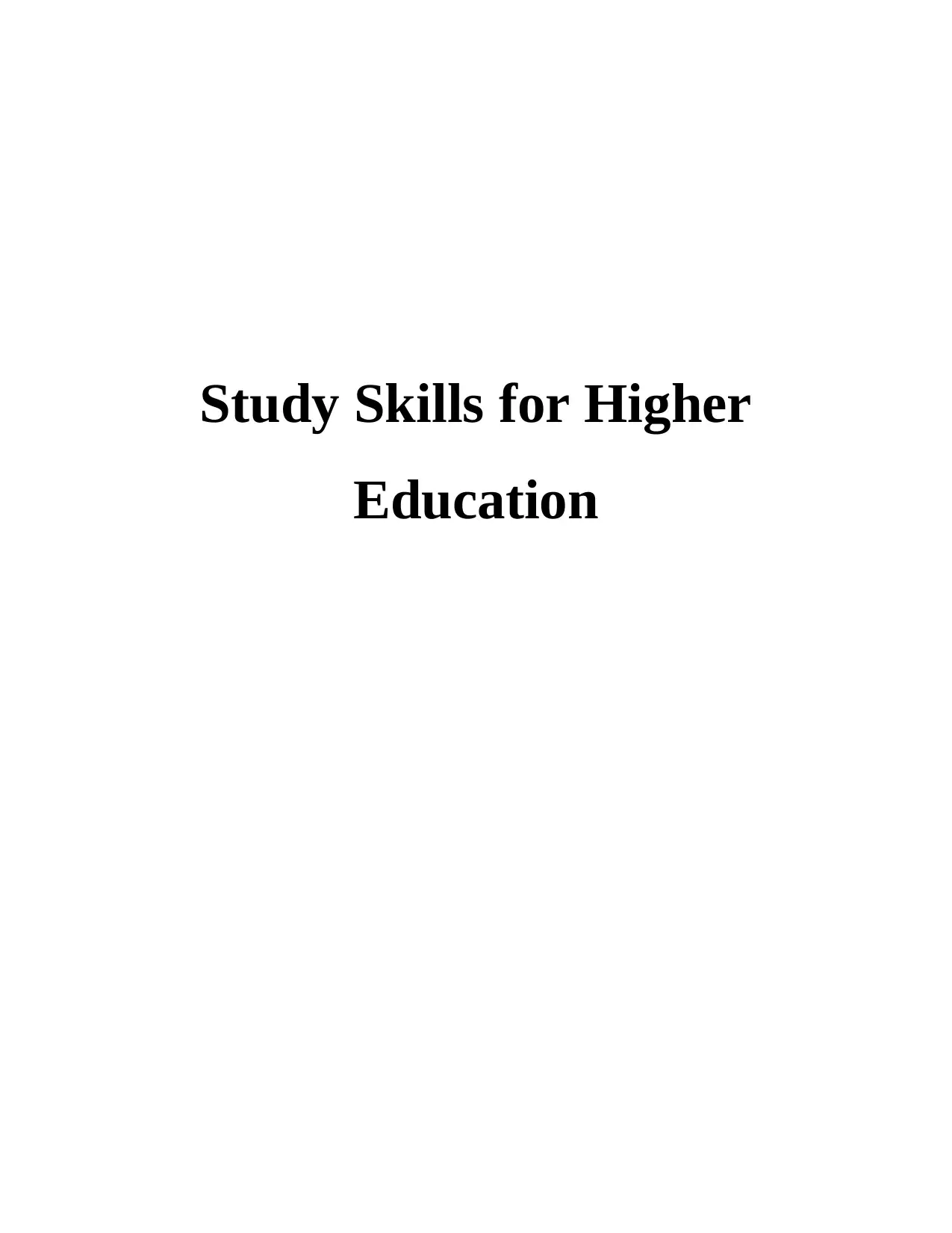
Study Skills for Higher
Education
Education
Secure Best Marks with AI Grader
Need help grading? Try our AI Grader for instant feedback on your assignments.
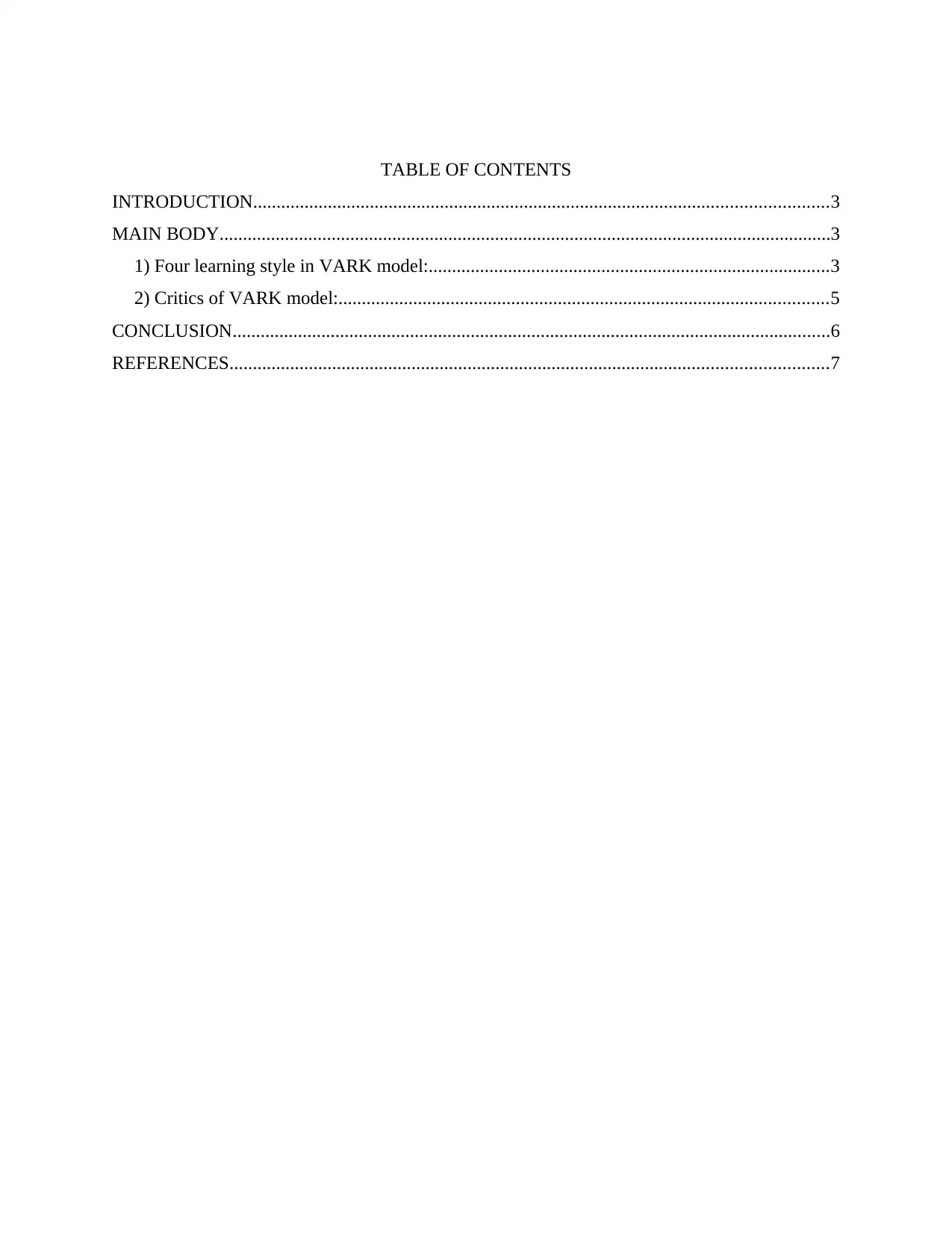
TABLE OF CONTENTS
INTRODUCTION...........................................................................................................................3
MAIN BODY...................................................................................................................................3
1) Four learning style in VARK model:......................................................................................3
2) Critics of VARK model:.........................................................................................................5
CONCLUSION................................................................................................................................6
REFERENCES................................................................................................................................7
INTRODUCTION...........................................................................................................................3
MAIN BODY...................................................................................................................................3
1) Four learning style in VARK model:......................................................................................3
2) Critics of VARK model:.........................................................................................................5
CONCLUSION................................................................................................................................6
REFERENCES................................................................................................................................7
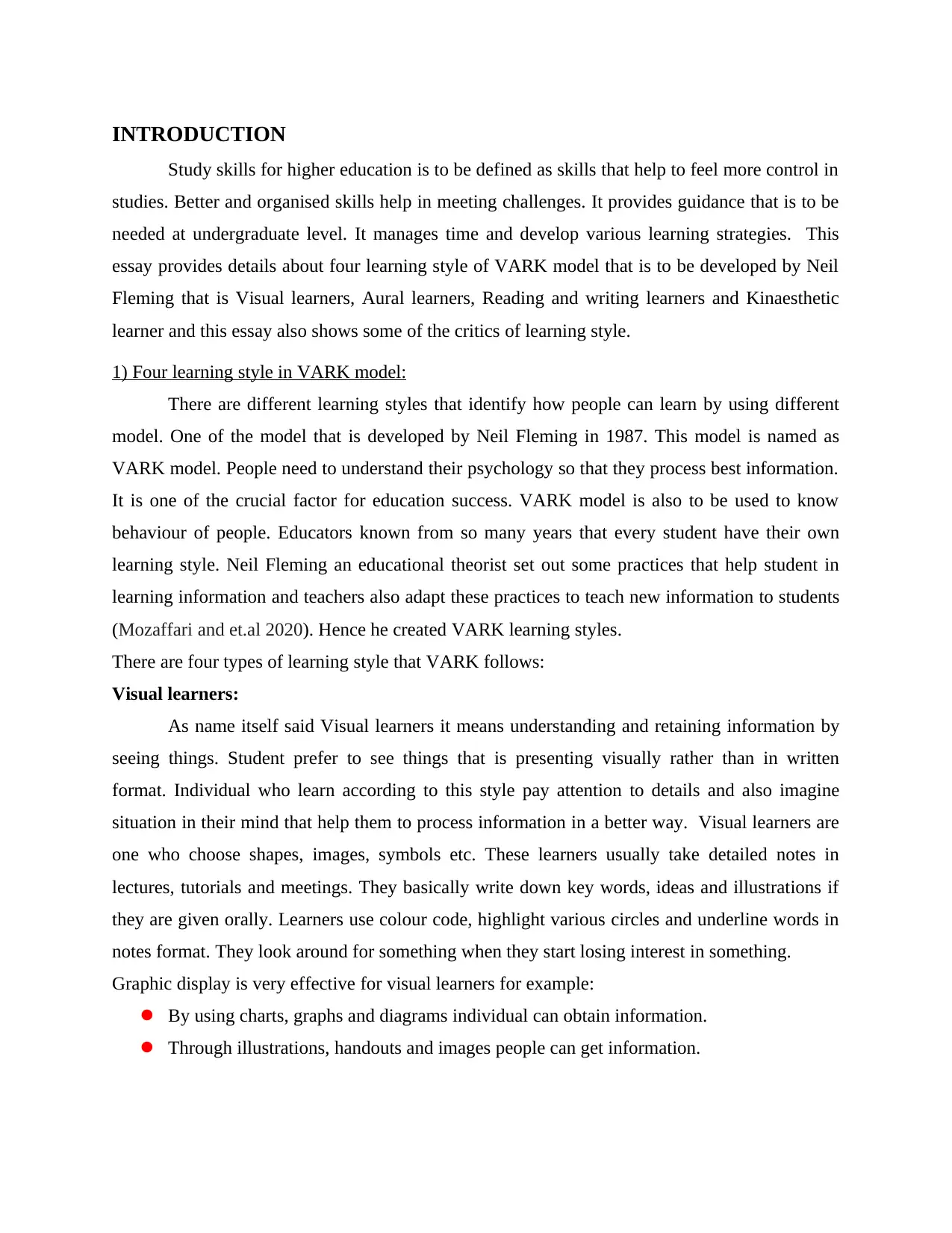
INTRODUCTION
Study skills for higher education is to be defined as skills that help to feel more control in
studies. Better and organised skills help in meeting challenges. It provides guidance that is to be
needed at undergraduate level. It manages time and develop various learning strategies. This
essay provides details about four learning style of VARK model that is to be developed by Neil
Fleming that is Visual learners, Aural learners, Reading and writing learners and Kinaesthetic
learner and this essay also shows some of the critics of learning style.
1) Four learning style in VARK model:
There are different learning styles that identify how people can learn by using different
model. One of the model that is developed by Neil Fleming in 1987. This model is named as
VARK model. People need to understand their psychology so that they process best information.
It is one of the crucial factor for education success. VARK model is also to be used to know
behaviour of people. Educators known from so many years that every student have their own
learning style. Neil Fleming an educational theorist set out some practices that help student in
learning information and teachers also adapt these practices to teach new information to students
(Mozaffari and et.al 2020). Hence he created VARK learning styles.
There are four types of learning style that VARK follows:
Visual learners:
As name itself said Visual learners it means understanding and retaining information by
seeing things. Student prefer to see things that is presenting visually rather than in written
format. Individual who learn according to this style pay attention to details and also imagine
situation in their mind that help them to process information in a better way. Visual learners are
one who choose shapes, images, symbols etc. These learners usually take detailed notes in
lectures, tutorials and meetings. They basically write down key words, ideas and illustrations if
they are given orally. Learners use colour code, highlight various circles and underline words in
notes format. They look around for something when they start losing interest in something.
Graphic display is very effective for visual learners for example:
By using charts, graphs and diagrams individual can obtain information.
Through illustrations, handouts and images people can get information.
Study skills for higher education is to be defined as skills that help to feel more control in
studies. Better and organised skills help in meeting challenges. It provides guidance that is to be
needed at undergraduate level. It manages time and develop various learning strategies. This
essay provides details about four learning style of VARK model that is to be developed by Neil
Fleming that is Visual learners, Aural learners, Reading and writing learners and Kinaesthetic
learner and this essay also shows some of the critics of learning style.
1) Four learning style in VARK model:
There are different learning styles that identify how people can learn by using different
model. One of the model that is developed by Neil Fleming in 1987. This model is named as
VARK model. People need to understand their psychology so that they process best information.
It is one of the crucial factor for education success. VARK model is also to be used to know
behaviour of people. Educators known from so many years that every student have their own
learning style. Neil Fleming an educational theorist set out some practices that help student in
learning information and teachers also adapt these practices to teach new information to students
(Mozaffari and et.al 2020). Hence he created VARK learning styles.
There are four types of learning style that VARK follows:
Visual learners:
As name itself said Visual learners it means understanding and retaining information by
seeing things. Student prefer to see things that is presenting visually rather than in written
format. Individual who learn according to this style pay attention to details and also imagine
situation in their mind that help them to process information in a better way. Visual learners are
one who choose shapes, images, symbols etc. These learners usually take detailed notes in
lectures, tutorials and meetings. They basically write down key words, ideas and illustrations if
they are given orally. Learners use colour code, highlight various circles and underline words in
notes format. They look around for something when they start losing interest in something.
Graphic display is very effective for visual learners for example:
By using charts, graphs and diagrams individual can obtain information.
Through illustrations, handouts and images people can get information.
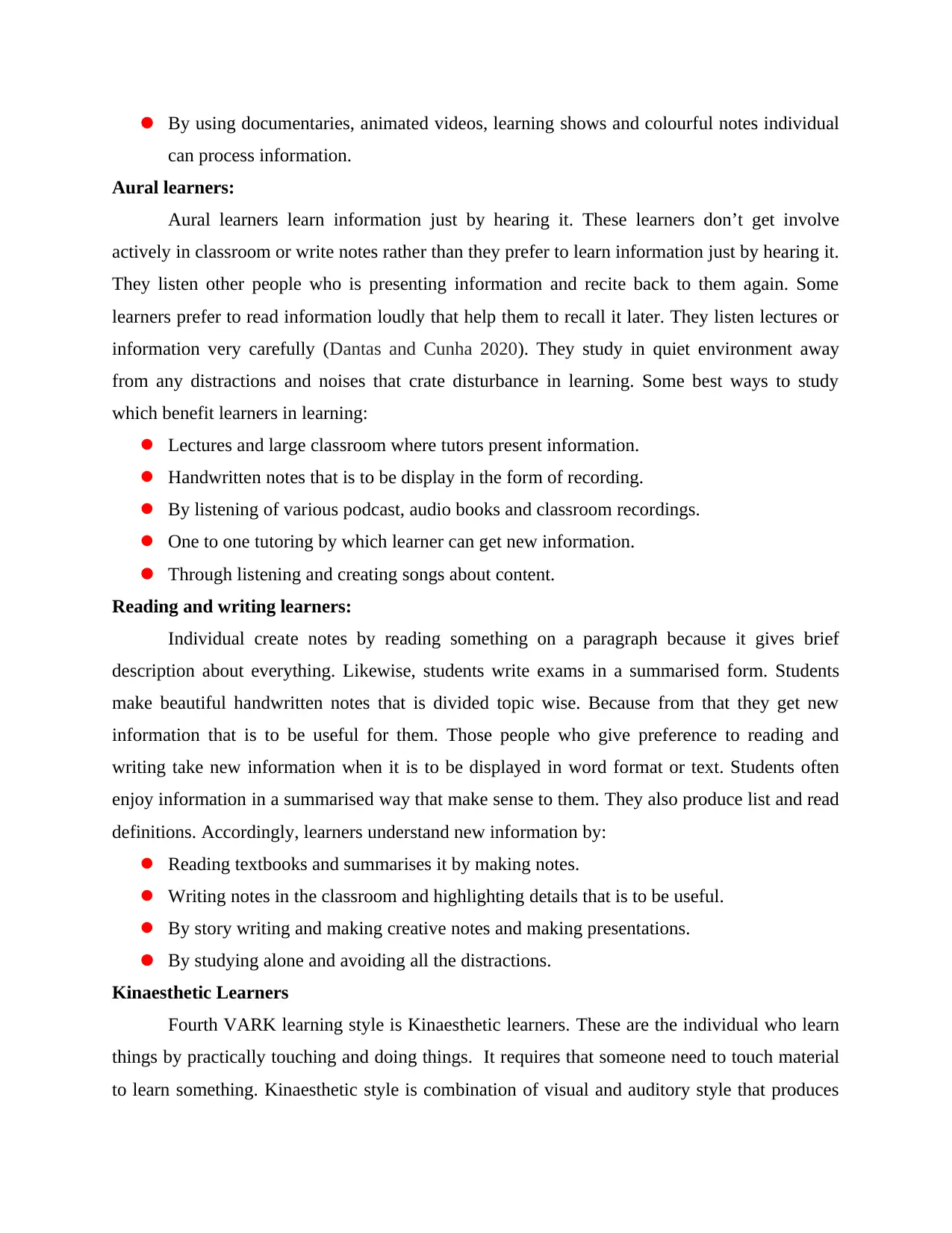
By using documentaries, animated videos, learning shows and colourful notes individual
can process information.
Aural learners:
Aural learners learn information just by hearing it. These learners don’t get involve
actively in classroom or write notes rather than they prefer to learn information just by hearing it.
They listen other people who is presenting information and recite back to them again. Some
learners prefer to read information loudly that help them to recall it later. They listen lectures or
information very carefully (Dantas and Cunha 2020). They study in quiet environment away
from any distractions and noises that crate disturbance in learning. Some best ways to study
which benefit learners in learning:
Lectures and large classroom where tutors present information.
Handwritten notes that is to be display in the form of recording.
By listening of various podcast, audio books and classroom recordings.
One to one tutoring by which learner can get new information.
Through listening and creating songs about content.
Reading and writing learners:
Individual create notes by reading something on a paragraph because it gives brief
description about everything. Likewise, students write exams in a summarised form. Students
make beautiful handwritten notes that is divided topic wise. Because from that they get new
information that is to be useful for them. Those people who give preference to reading and
writing take new information when it is to be displayed in word format or text. Students often
enjoy information in a summarised way that make sense to them. They also produce list and read
definitions. Accordingly, learners understand new information by:
Reading textbooks and summarises it by making notes.
Writing notes in the classroom and highlighting details that is to be useful.
By story writing and making creative notes and making presentations.
By studying alone and avoiding all the distractions.
Kinaesthetic Learners
Fourth VARK learning style is Kinaesthetic learners. These are the individual who learn
things by practically touching and doing things. It requires that someone need to touch material
to learn something. Kinaesthetic style is combination of visual and auditory style that produces
can process information.
Aural learners:
Aural learners learn information just by hearing it. These learners don’t get involve
actively in classroom or write notes rather than they prefer to learn information just by hearing it.
They listen other people who is presenting information and recite back to them again. Some
learners prefer to read information loudly that help them to recall it later. They listen lectures or
information very carefully (Dantas and Cunha 2020). They study in quiet environment away
from any distractions and noises that crate disturbance in learning. Some best ways to study
which benefit learners in learning:
Lectures and large classroom where tutors present information.
Handwritten notes that is to be display in the form of recording.
By listening of various podcast, audio books and classroom recordings.
One to one tutoring by which learner can get new information.
Through listening and creating songs about content.
Reading and writing learners:
Individual create notes by reading something on a paragraph because it gives brief
description about everything. Likewise, students write exams in a summarised form. Students
make beautiful handwritten notes that is divided topic wise. Because from that they get new
information that is to be useful for them. Those people who give preference to reading and
writing take new information when it is to be displayed in word format or text. Students often
enjoy information in a summarised way that make sense to them. They also produce list and read
definitions. Accordingly, learners understand new information by:
Reading textbooks and summarises it by making notes.
Writing notes in the classroom and highlighting details that is to be useful.
By story writing and making creative notes and making presentations.
By studying alone and avoiding all the distractions.
Kinaesthetic Learners
Fourth VARK learning style is Kinaesthetic learners. These are the individual who learn
things by practically touching and doing things. It requires that someone need to touch material
to learn something. Kinaesthetic style is combination of visual and auditory style that produces
Secure Best Marks with AI Grader
Need help grading? Try our AI Grader for instant feedback on your assignments.
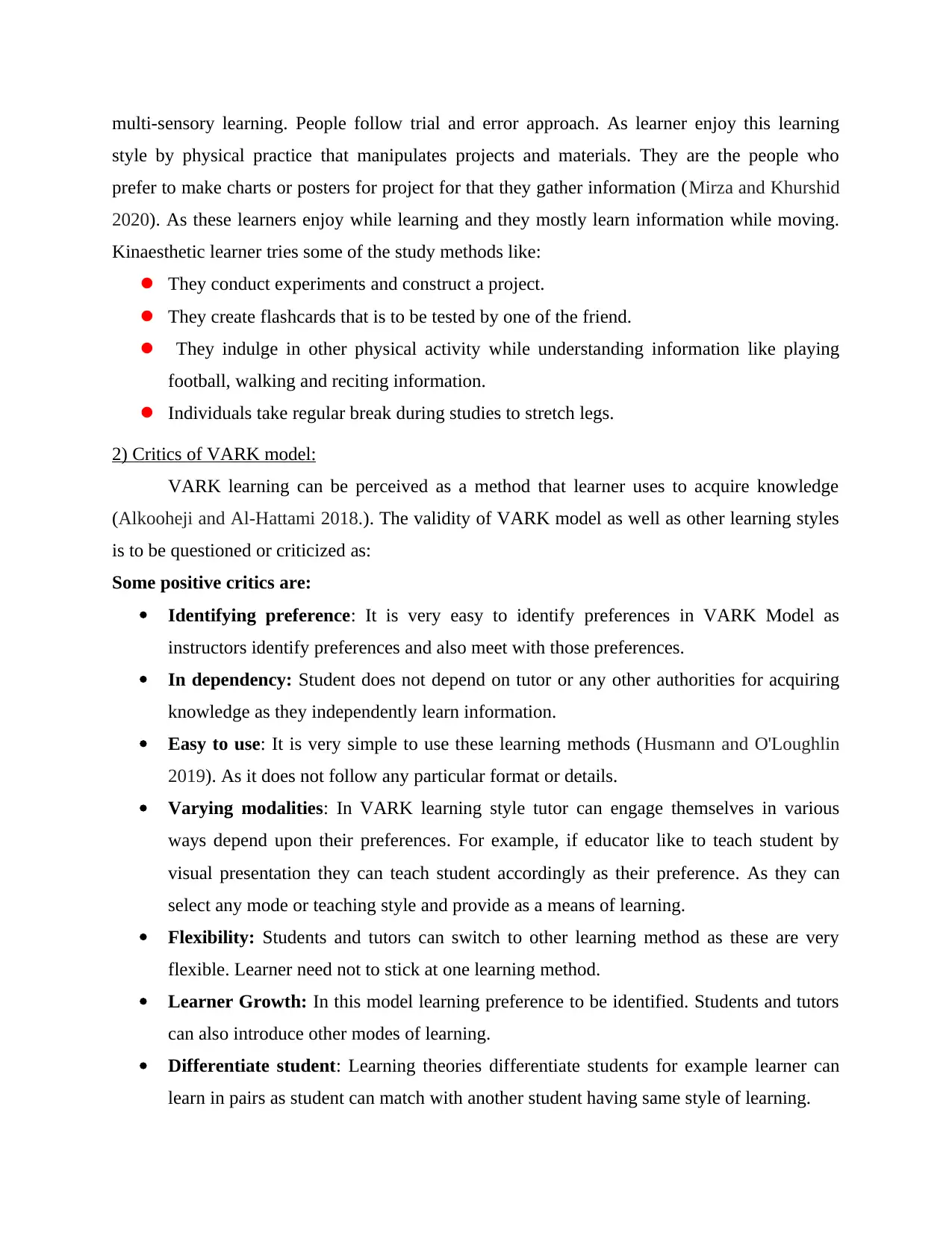
multi-sensory learning. People follow trial and error approach. As learner enjoy this learning
style by physical practice that manipulates projects and materials. They are the people who
prefer to make charts or posters for project for that they gather information (Mirza and Khurshid
2020). As these learners enjoy while learning and they mostly learn information while moving.
Kinaesthetic learner tries some of the study methods like:
They conduct experiments and construct a project.
They create flashcards that is to be tested by one of the friend.
They indulge in other physical activity while understanding information like playing
football, walking and reciting information.
Individuals take regular break during studies to stretch legs.
2) Critics of VARK model:
VARK learning can be perceived as a method that learner uses to acquire knowledge
(Alkooheji and Al-Hattami 2018.). The validity of VARK model as well as other learning styles
is to be questioned or criticized as:
Some positive critics are:
Identifying preference: It is very easy to identify preferences in VARK Model as
instructors identify preferences and also meet with those preferences.
In dependency: Student does not depend on tutor or any other authorities for acquiring
knowledge as they independently learn information.
Easy to use: It is very simple to use these learning methods (Husmann and O'Loughlin
2019). As it does not follow any particular format or details.
Varying modalities: In VARK learning style tutor can engage themselves in various
ways depend upon their preferences. For example, if educator like to teach student by
visual presentation they can teach student accordingly as their preference. As they can
select any mode or teaching style and provide as a means of learning.
Flexibility: Students and tutors can switch to other learning method as these are very
flexible. Learner need not to stick at one learning method.
Learner Growth: In this model learning preference to be identified. Students and tutors
can also introduce other modes of learning.
Differentiate student: Learning theories differentiate students for example learner can
learn in pairs as student can match with another student having same style of learning.
style by physical practice that manipulates projects and materials. They are the people who
prefer to make charts or posters for project for that they gather information (Mirza and Khurshid
2020). As these learners enjoy while learning and they mostly learn information while moving.
Kinaesthetic learner tries some of the study methods like:
They conduct experiments and construct a project.
They create flashcards that is to be tested by one of the friend.
They indulge in other physical activity while understanding information like playing
football, walking and reciting information.
Individuals take regular break during studies to stretch legs.
2) Critics of VARK model:
VARK learning can be perceived as a method that learner uses to acquire knowledge
(Alkooheji and Al-Hattami 2018.). The validity of VARK model as well as other learning styles
is to be questioned or criticized as:
Some positive critics are:
Identifying preference: It is very easy to identify preferences in VARK Model as
instructors identify preferences and also meet with those preferences.
In dependency: Student does not depend on tutor or any other authorities for acquiring
knowledge as they independently learn information.
Easy to use: It is very simple to use these learning methods (Husmann and O'Loughlin
2019). As it does not follow any particular format or details.
Varying modalities: In VARK learning style tutor can engage themselves in various
ways depend upon their preferences. For example, if educator like to teach student by
visual presentation they can teach student accordingly as their preference. As they can
select any mode or teaching style and provide as a means of learning.
Flexibility: Students and tutors can switch to other learning method as these are very
flexible. Learner need not to stick at one learning method.
Learner Growth: In this model learning preference to be identified. Students and tutors
can also introduce other modes of learning.
Differentiate student: Learning theories differentiate students for example learner can
learn in pairs as student can match with another student having same style of learning.
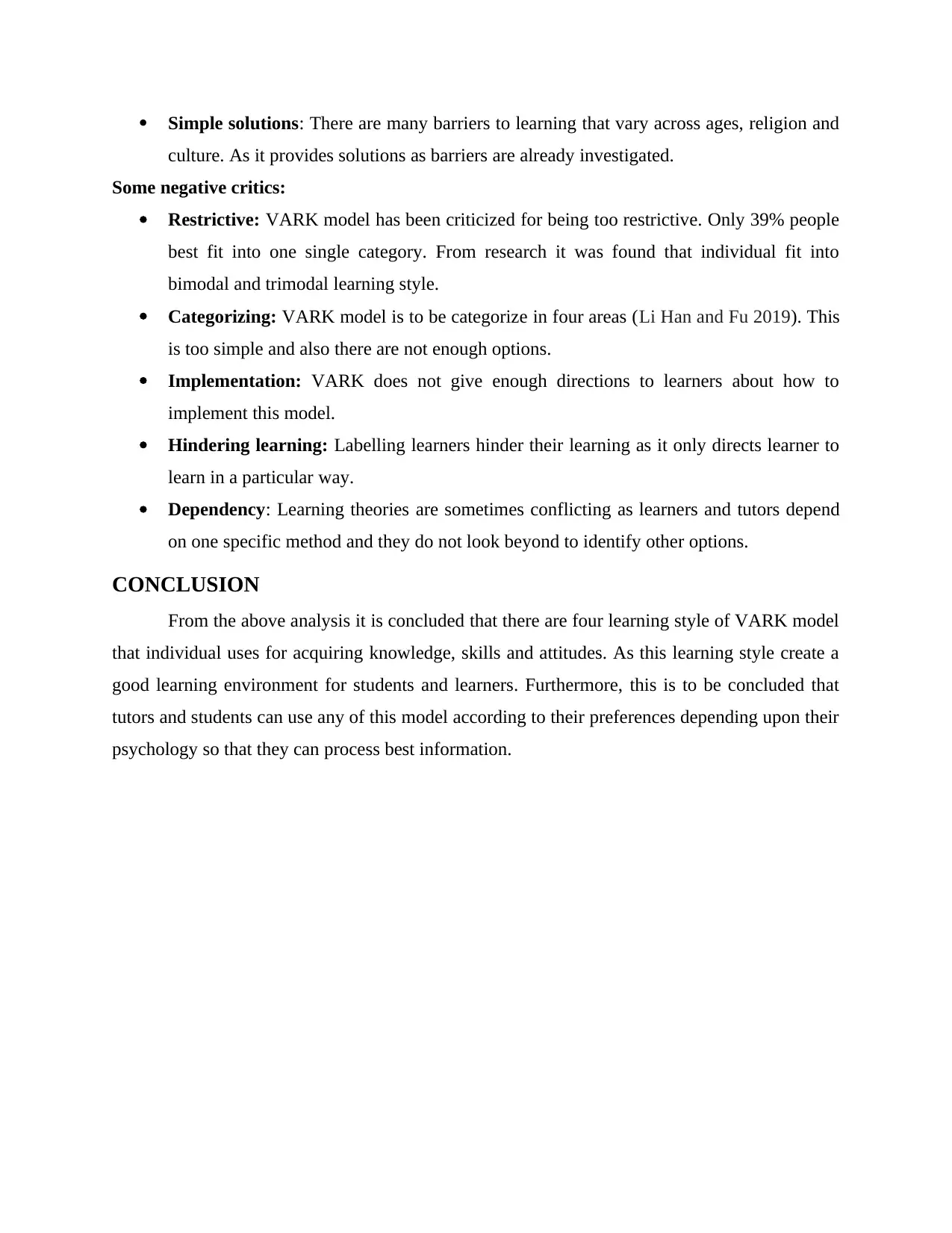
Simple solutions: There are many barriers to learning that vary across ages, religion and
culture. As it provides solutions as barriers are already investigated.
Some negative critics:
Restrictive: VARK model has been criticized for being too restrictive. Only 39% people
best fit into one single category. From research it was found that individual fit into
bimodal and trimodal learning style.
Categorizing: VARK model is to be categorize in four areas (Li Han and Fu 2019). This
is too simple and also there are not enough options.
Implementation: VARK does not give enough directions to learners about how to
implement this model.
Hindering learning: Labelling learners hinder their learning as it only directs learner to
learn in a particular way.
Dependency: Learning theories are sometimes conflicting as learners and tutors depend
on one specific method and they do not look beyond to identify other options.
CONCLUSION
From the above analysis it is concluded that there are four learning style of VARK model
that individual uses for acquiring knowledge, skills and attitudes. As this learning style create a
good learning environment for students and learners. Furthermore, this is to be concluded that
tutors and students can use any of this model according to their preferences depending upon their
psychology so that they can process best information.
culture. As it provides solutions as barriers are already investigated.
Some negative critics:
Restrictive: VARK model has been criticized for being too restrictive. Only 39% people
best fit into one single category. From research it was found that individual fit into
bimodal and trimodal learning style.
Categorizing: VARK model is to be categorize in four areas (Li Han and Fu 2019). This
is too simple and also there are not enough options.
Implementation: VARK does not give enough directions to learners about how to
implement this model.
Hindering learning: Labelling learners hinder their learning as it only directs learner to
learn in a particular way.
Dependency: Learning theories are sometimes conflicting as learners and tutors depend
on one specific method and they do not look beyond to identify other options.
CONCLUSION
From the above analysis it is concluded that there are four learning style of VARK model
that individual uses for acquiring knowledge, skills and attitudes. As this learning style create a
good learning environment for students and learners. Furthermore, this is to be concluded that
tutors and students can use any of this model according to their preferences depending upon their
psychology so that they can process best information.
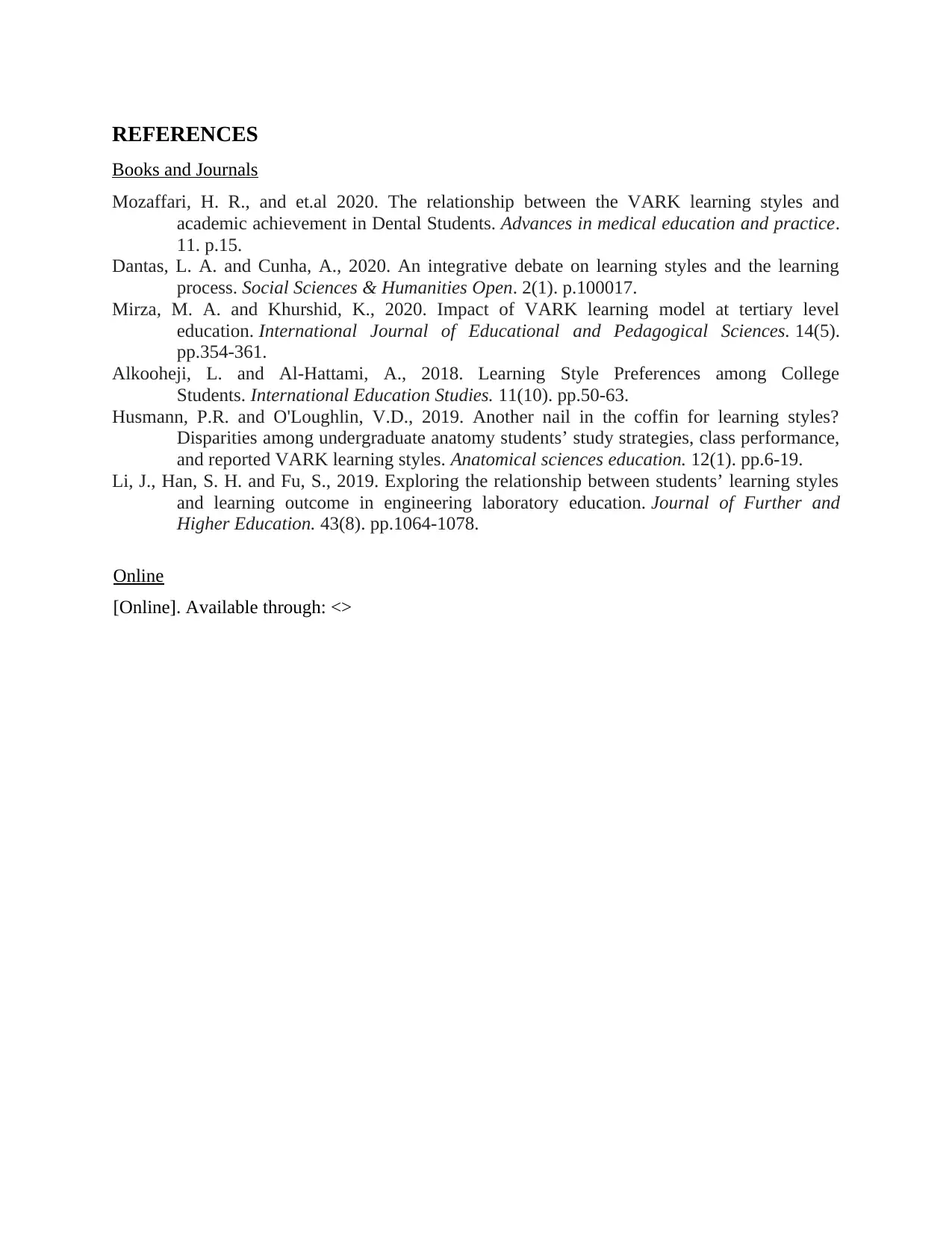
REFERENCES
Books and Journals
Mozaffari, H. R., and et.al 2020. The relationship between the VARK learning styles and
academic achievement in Dental Students. Advances in medical education and practice.
11. p.15.
Dantas, L. A. and Cunha, A., 2020. An integrative debate on learning styles and the learning
process. Social Sciences & Humanities Open. 2(1). p.100017.
Mirza, M. A. and Khurshid, K., 2020. Impact of VARK learning model at tertiary level
education. International Journal of Educational and Pedagogical Sciences. 14(5).
pp.354-361.
Alkooheji, L. and Al-Hattami, A., 2018. Learning Style Preferences among College
Students. International Education Studies. 11(10). pp.50-63.
Husmann, P.R. and O'Loughlin, V.D., 2019. Another nail in the coffin for learning styles?
Disparities among undergraduate anatomy students’ study strategies, class performance,
and reported VARK learning styles. Anatomical sciences education. 12(1). pp.6-19.
Li, J., Han, S. H. and Fu, S., 2019. Exploring the relationship between students’ learning styles
and learning outcome in engineering laboratory education. Journal of Further and
Higher Education. 43(8). pp.1064-1078.
Online
[Online]. Available through: <>
Books and Journals
Mozaffari, H. R., and et.al 2020. The relationship between the VARK learning styles and
academic achievement in Dental Students. Advances in medical education and practice.
11. p.15.
Dantas, L. A. and Cunha, A., 2020. An integrative debate on learning styles and the learning
process. Social Sciences & Humanities Open. 2(1). p.100017.
Mirza, M. A. and Khurshid, K., 2020. Impact of VARK learning model at tertiary level
education. International Journal of Educational and Pedagogical Sciences. 14(5).
pp.354-361.
Alkooheji, L. and Al-Hattami, A., 2018. Learning Style Preferences among College
Students. International Education Studies. 11(10). pp.50-63.
Husmann, P.R. and O'Loughlin, V.D., 2019. Another nail in the coffin for learning styles?
Disparities among undergraduate anatomy students’ study strategies, class performance,
and reported VARK learning styles. Anatomical sciences education. 12(1). pp.6-19.
Li, J., Han, S. H. and Fu, S., 2019. Exploring the relationship between students’ learning styles
and learning outcome in engineering laboratory education. Journal of Further and
Higher Education. 43(8). pp.1064-1078.
Online
[Online]. Available through: <>
1 out of 7
Related Documents
Your All-in-One AI-Powered Toolkit for Academic Success.
+13062052269
info@desklib.com
Available 24*7 on WhatsApp / Email
![[object Object]](/_next/static/media/star-bottom.7253800d.svg)
Unlock your academic potential
© 2024 | Zucol Services PVT LTD | All rights reserved.




